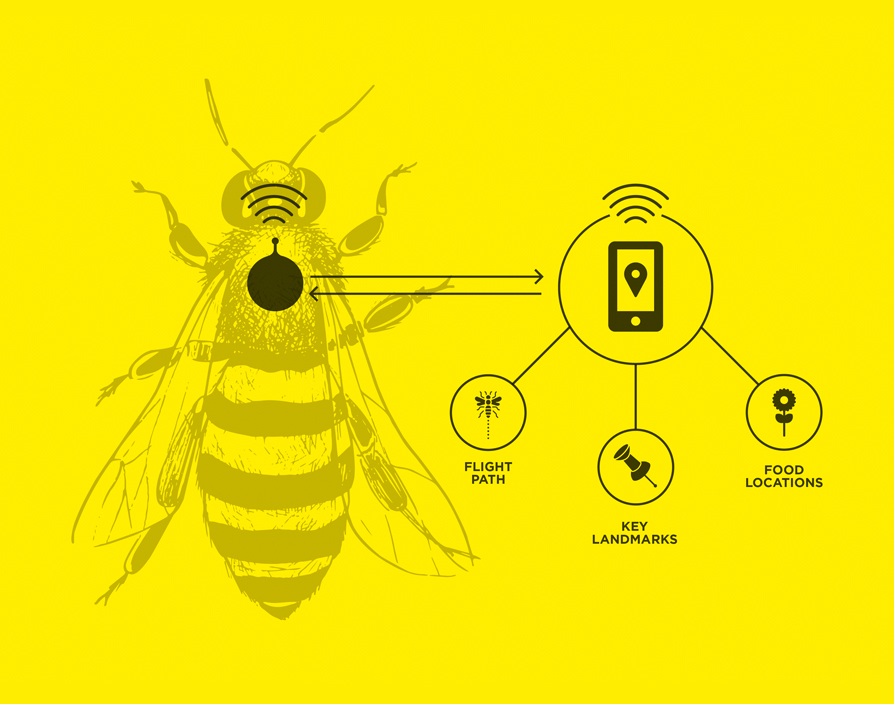Photo credit: Rock Level
The bees are disappearing. The introduction of new pesticides like neonicotinoids have caused the UK population of 353 species of wild bees and hoverflies to drop by roughly 33% since the 1980s, according to research from the Centre for Ecology & Hydrology. “I don’t think people actually realise the scale of the problem when it comes to rapidly declining numbers,” warns Neil Swindlehurst, chief creative officer at Rock Level. That’s why the Chippenham-based tech firm is dead set on stopping the extinction event before it’s too late by essentially putting backpacks on bees to track them. “This is a very personal project for us at Rock Level,” says Swindlehurst. “We’d always been animal lovers but the more that my business partner and I learnt about the plight of bees the more compelled we felt to do something to help.”
In 2015, this commitment led them to the local council to pitch the first iteration of their bee-tracking technology. That’s when they met a beekeeper from Sirhowy Valley Honey Bee Company who’d been searching for devices that’d enable the firm to trace the bees’ behaviours. “I told him that in the past we had created tracking technology and hardware for other projects and we found that we had a mutual goal,” Swindlehurst recalls. “Our chance meeting with the beekeeper inspired us all to take action – we knew that we had the tools to help, we just needed to find a way to get our technology to market.”
To fund the project, Rock Level set up a community interest company. To raise awareness of the need for the project the team held talks around the country. “We have also done a huge amount of fundraising to [support] the project, selling everything from branded honey to wrist bands,” he says. This includes a research and development claim from ForrestBrown, the R&D tax credit consultancy.
Thanks to these efforts, Rock Level began to develop its tracking device. “We have undertaken a number of consultations with the beekeeping community and also spoken with universities to ensure that we could find a cost effective and affordable solution for the hardware that we were using,” Swindlehurst says.
It was through these conversations the team learned that beekeepers already place small metal disks on queen bees to help identify them and to make it easier to pick them up with magnets. “[We] choose to follow suit,” reveals Swindlehurst.
Their take on this was to develop a lightweight radio frequency tag that’s put on the back of the bees. These backpacks then send GPS location data to a computer which, hopefully, will provide some key insights into what can be done to prevent the number of pollinators to dwindle even further.
That doesn’t mean there weren’t some hurdles to overcome. “There are of course some variables such as the size or range of the bee to consider but we worked tirelessly to ensure that the algorithms were right,” he explains. “The other hurdle was creating the right size of tracker, to ensure that it is a suitable weight for all bees, no matter their size – not just drones and larger bees. We’re currently refining this.”
And putting the backpacks onto the bees seems surprisingly simple. “[We] use a tube-like device which has a slit on it,” explains Swindlehurst. “You gently put the bee in the tube. As they go into the tube, they put their wings down and once they’ve settled, you then carefully apply a specially formulated glue onto the back of the bee before adding on the very light weight tracker. Once this has successfully stuck to the bee, you then release them into the wild and let them carry on their daily lives.”
Rock Level isn’t alone – beetech startups seems to be buzzing recently. In November 2018, Irish agriculture technology startup ApisProtect raised a $1.8m seed round to keep developing in-hive sensors to unobtrusively monitor honey bee colonies and prevent losses. In Sweden, BeeScanning is leveraging machine learning to alert beekeepers to the presence of varroa mites or varroa destructors, which kills bees, in their colonies with a simple smartphone photo. In Germany, networking platform BEEsharing is essentially hooking up farmers with beekeepers to help them pollinate their crops.
Despite being in good company, the developers at Rock Level aren’t resting on their laurels. “We are currently in the middle of creating a new and improved tracker and chip,” reveals Swindlehurst. “The new chip is programmable and smaller than before, so along with the rebuild of the tracker and a new algorithm, we should be in a position to test this further by the summer.”
They’re also exploring ways to remove the current devices’ batteries and instead use the kinetic energy from the bees themselves to power them. Moreover, they’re considering opening an education centre for the public to help teach them about bees. “Finally, if time and resource permits, we would also like to track the bee in real-time by following the bee in flight by using small drones so that we can actually see what type of flowers and plants they land on as well as understanding how far they travel,” he continues. “If we can tap into this knowledge, we can then think about ways to help move bees to areas where they can best thrive by avoiding pesticides and so on.”
While the bees disappearing has inspired everything from comics to plot points in Doctor Who, hopefully Rock Level and the other startups’ efforts will help prevent these important pollinators from going extinct. ![]()
Share via:








































